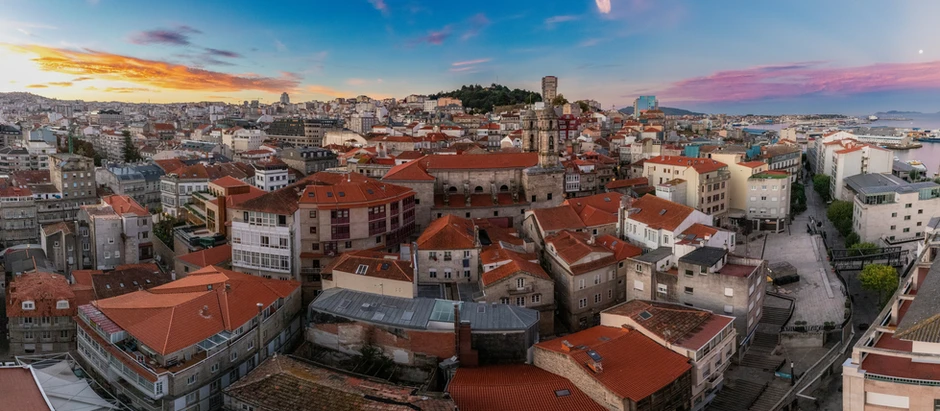How to Get There Vigo, located in the Galicia region of northwestern Spain, is accessible by several travel options. Here’s a breakdown of the most practical ways to reach this coastal city from the UK:
By Air Vigo has a small regional airport (Vigo-Peinador Airport, VGO) but is not directly served by many UK airports. The most common approach is flying to a larger Spanish city like Madrid or Barcelona and connecting to Vigo. Direct flights from London to Madrid or Barcelona typically range from £50 to £120, depending on the season. A connecting flight to Vigo can add around £30 to £70.
- High season (July-August, Christmas): Prices tend to be at their peak, with return flights potentially exceeding £150.
- Off-peak (January-March, October-November): Off-season flights from London to Madrid or Barcelona can dip as low as £40, with onward flights to Vigo around £25. This is the best time to score a bargain, although be mindful of winter weather, which can bring heavy rainfall and grey skies in Galicia.
By Train Traveling by train offers scenic routes through Spain. Eurostar from London to Paris starts at about £40, followed by a connection to Irun, then an onward Spanish train to Vigo. Total ticket prices may vary from £150 to £250, depending on the time of year and booking window. This route is time-consuming, taking up to 24 hours, but it is ideal for those who enjoy a more leisurely, environmentally-friendly journey.
By Ferry For those who prefer to avoid flying, Brittany Ferries offers a ferry service from Portsmouth or Plymouth to Santander. From Santander, you can either drive (about 5 hours) or take a train to Vigo. Ferry prices range from £100 to £250 per person, and driving costs should account for fuel and tolls, adding an estimated £50 to £100.
Peak vs Off-Peak Travel Peak season in Vigo spans July to September when summer tourists flock to the beaches and the weather is at its finest. While prices for flights and accommodation will be highest during these months, the warm weather and lively atmosphere make it a popular choice. However, travelling in late spring (May-June) or early autumn (September-October) can provide a good balance between pleasant weather and lower costs. The winter months (December to February) are the cheapest for travel, though attractions may be limited, and rain is common.
Typical Weather by Month
- January-February: Cold, with frequent rain. Average highs of 12°C, lows of 6°C.
- March-April: Warmer, more frequent sunshine, but rain still prevalent. Highs of 15°C.
- May-June: Spring weather, highs around 20°C, ideal for sightseeing.
- July-August: Peak summer, sunny and dry, with temperatures reaching 25°C or higher.
- September-October: Mild with occasional rain, highs of 18-22°C.
- November-December: Cooler and wetter, highs of 10-15°C.
How to Save Money on Accommodation
Vigo offers accommodation for a range of budgets, from affordable hostels to luxury stays. Below are three options representing different price ranges:
Budget: Hostal Real Vigo
Located in the city centre, this budget-friendly hostel offers clean, basic rooms with private bathrooms. Ideal for solo travellers or couples.
Price: Around £35 per night during the off-season, rising to £50 in peak summer.
Website: Hostal Real Vigo on Booking.com.
Mid-Range: Hotel Bahía de Vigo
This 4-star hotel provides spacious rooms with stunning views over the Vigo estuary. A good mix of comfort and value, it’s close to the Old Town and port.
Price: £60-£90 per night, depending on the season.
Website: Hotel Bahía de Vigo on Expedia.
Luxury: Gran Hotel Nagari Boutique & Spa
This 5-star boutique hotel offers luxurious rooms and spa services. Located in the city centre, it’s perfect for those seeking a premium experience.
Price: £140-£250 per night.
Website: Gran Hotel Nagari on Expedia.
Top Five Things to See in Vigo
- Casco Vello (Old Town) The historic centre of Vigo is perfect for a day of exploring narrow streets, quaint shops, and traditional Galician architecture. Visit the Santa María Collegiate Church and enjoy local tapas at one of the many bars. Entrance is free, but meals typically cost around £8-£12.
- Parque del Castro A large hilltop park offering panoramic views over Vigo and the Ría de Vigo. The park features ancient ruins, walking trails, and picnic spots. Entry is free, making it a budget-friendly outing.
- Cíes Islands Often referred to as the “Galician Caribbean”, these pristine islands offer stunning beaches and nature trails. Ferries run from Vigo’s port and cost around £18-£20 return. Be sure to bring your own snacks, as island prices can be steep.
- Museo de Arte Contemporáneo (MARCO) A modern art museum housed in a striking building in the heart of the city. Entrance is free, making it a great cultural stop.
- Port of Vigo One of Europe’s largest fishing ports, the Port of Vigo is worth visiting for its maritime atmosphere and fresh seafood restaurants. Walking along the port is free, while meals in nearby restaurants can range from £12 to £20.

10 Money-Saving Tips for Vigo
- Travel Off-Peak Visit in late spring or early autumn to enjoy milder weather and lower accommodation and travel costs. Off-season flights to Vigo via Madrid can be found for as low as £40, while accommodation prices drop significantly.
- Book Accommodation Early Early booking often comes with discounts, especially for mid-range and luxury hotels. Websites like Booking.com frequently offer early-bird deals for popular spots like the Hotel Bahía de Vigo.
- Public Transport Vigo is a walkable city, but for longer distances, the local buses are inexpensive, with a single ticket costing about £1.35. Consider buying a rechargeable “Vitrasa” travel card for further savings on multiple trips.
- Eat Like a Local Seek out “menu del día” options at local restaurants, which typically offer a multi-course meal for around £8-£12. This is a great way to sample Galician cuisine without overspending.
- Free Museums and Attractions Take advantage of free entry to several attractions, such as MARCO (Museo de Arte Contemporáneo) and Parque del Castro. This saves on sightseeing costs, allowing you to allocate your budget elsewhere.
- Shop at Local Markets Visit local markets like Mercado de la Piedra, where you can buy affordable, fresh produce, seafood, and souvenirs. This is also an excellent place to stock up on picnic supplies if you’re planning a day at the beach.
- Explore the Outdoors Many of Vigo’s best attractions, including its beaches, parks, and walking trails, are free to enjoy. A trip to the Cíes Islands, though requiring a ferry fare, can be a cost-effective way to spend an entire day.
- Use Ferry Discounts If you plan to visit the Cíes Islands or take other ferries, book online in advance to access discounted rates. Early morning or late afternoon ferries often have lower prices.
- Self-Catering Options Consider renting an apartment or staying in a hostel with kitchen facilities to prepare your own meals. Supermarkets in Vigo offer fresh produce, bread, and other essentials at low prices, allowing you to save on dining costs.
- Walk or Bike Vigo is very pedestrian-friendly, and many of its attractions are within walking distance. Alternatively, rent a bike to explore the city for just a few euros a day, saving on transport costs.
This guide aims to provide UK travellers with practical advice to explore Vigo affordably. With careful planning, you can enjoy this vibrant Galician city without breaking the bank.



